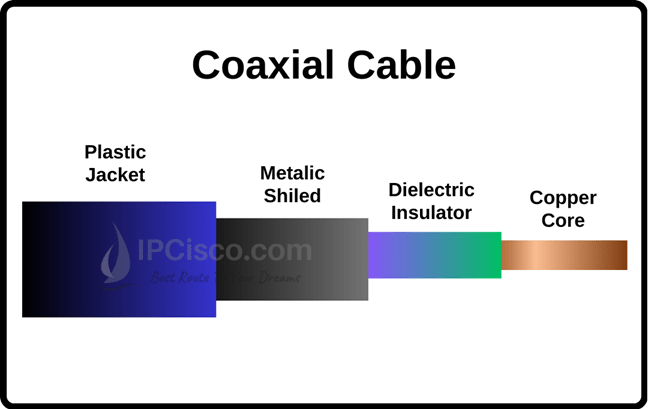- COURSES
- SPECIALS
- BLOG
- MEMBERS
- SHOP
- ABOUT
- ENROLL HERE

Table of Contents
Coaxial Cable is one of the network cable types that we use in computer networking. Coax is the short form of Coaxial. The term “coaxial” comes from the fact that the central conductor and the outer shield share a common axis, hence “co-axial.”
Coaxial cables are commonly used for transmitting high-frequency electrical signals, particularly for applications such as television distribution, internet connectivity, telecommunications, and networking. They are well-suited for these applications because of their ability to carry signals over long distances with minimal signal loss and interference.
To start learning Network Fundamentals, visit Cisco CCNA Certification Course!
There are different parts in a coaxial cable. These parts are given below:

The center conductor is a solid or stranded wire located at the core of the coaxial cable. It carries the electrical signal from one end of the cable to the other. The material and diameter of the center conductor can vary depending on the cable’s application and performance requirements.
Surrounding the center conductor is a layer of dielectric material, which provides insulation and support. The dielectric material helps maintain the integrity of the signal by preventing electrical interference and minimizing signal loss. Common dielectric materials include foam polyethylene, solid polyethylene, and polytetrafluoroethylene (PTFE).
The outer conductor, also known as the shield, surrounds the dielectric insulation and provides electromagnetic shielding. It consists of a conductive layer, typically made of metal such as aluminum or copper, that helps contain the electromagnetic fields generated by the signal. This shielding prevents external interference from disrupting the signal and also reduces signal leakage, improving overall cable performance.
The outermost layer of the coaxial cable is the jacket, which serves as protection against environmental factors such as moisture, abrasion, and physical damage. The jacket is usually made of a durable and flexible material such as PVC (polyvinyl chloride) or PE (polyethylene). It provides insulation and mechanical strength while also ensuring the longevity and reliability of the cable.
Coaxial cables are often terminated with connectors at each end to facilitate easy connection to devices or other cables. Common types of coaxial connectors include F-type connectors, BNC connectors, and N-type connectors. These connectors ensure a secure and reliable connection while maintaining the integrity of the signal transmission.
Both coaxial cable and fiber optic cable are widely used in different parts of networking. What are the differences of these two cable types. Let’s compare coaxial cable and fiber optic cable and learn their differences one by one.
First of all, the data transmission medium is different for these two network cable types. Transmission of signals is done in the electrical form over the inner conductor of coaxial cable. In fiber optic cable, transmission happens in optical form over a glass fiber.
If we compare these two cables for their costs, fiber optic cables are more costly. Coaxial cables are easy to install and they are not as expensive as fiber optic cables.
One of the most important differences between coaxial cable and fiber optic cable is about speed. Coaxial cable provides asymmetric speed which means uploading speed is faster than downloading speed. Fiber optic cables support symmetric speed. And this makes it much faster than coaxial cable.
Coaxial cables provide high bandwidth while fiber optic cables provide higher bandwidth.
Noise immunity is higher than twisted-pair in coaxial cable. But there is highest noise immunity in fiber optic cables.
RG-6 is one of the most common types of coaxial cables and is widely used for connecting devices such as cable modems, satellite receivers, and television sets. It typically has a thicker conductor and insulation compared to RG-59, providing better signal quality and performance, particularly for longer cable runs. RG-6 cables are commonly used for distributing cable television signals and high-speed internet connections in residential and commercial settings.
RG-11 is a heavier-duty coaxial cable primarily used for long-distance transmissions and high-frequency applications. It has a larger diameter conductor and thicker insulation compared to RG-6, which results in lower signal loss over longer distances. RG-11 cables are commonly used for applications such as connecting satellite dishes to receivers, distributing cable television signals in large buildings, and providing internet connectivity over long cable runs.
RG-58 is a thinner and more flexible coaxial cable often used for shorter cable runs and applications that require flexibility and mobility. It is commonly used in applications such as amateur radio antennas, Ethernet connections in networking, and some CCTV installations. While RG-58 is not as suitable for long-distance transmissions as RG-6 or RG-11 due to higher signal loss, its flexibility and affordability make it a popular choice for certain applications where mobility and ease of installation are important.
To start learning Network Fundamentals, visit Cisco CCNA Certification Course!
Leave a Reply